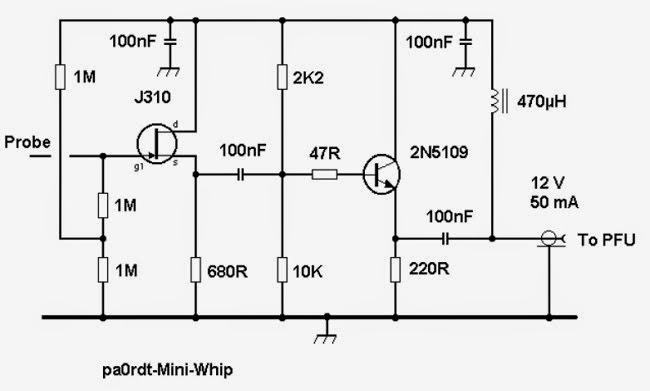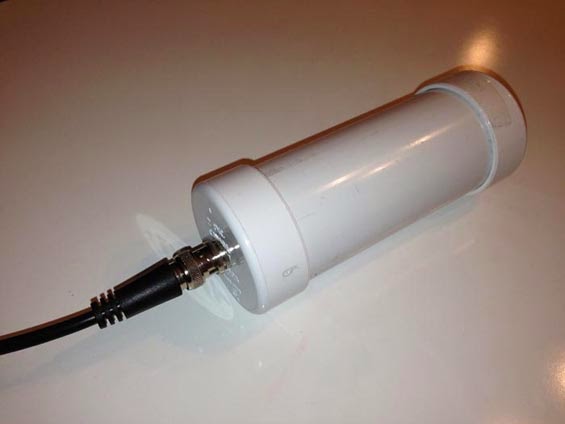Posts Tagged ‘power line noise’
 The PAØRDT Active Whip….On LF
The PAØRDT Active Whip….On LF
 |
| The Mini-Whip at University of Twente's (Netherlands) Remote Receiver |
I think many hams believe that they need big antennas and lots of space to operate on 630m or even to listen on the band. I can assure you that big antennas are definitely not needed to listen or for that matter, even to transmit effectively.
You might be surprised at just how well you can hear on 630m using one of your low band antennas, such as an 80m or 40m dipole. Best results will be had with the coaxial feed's shield lifted from ground and connected to the center pin. This, in effect, allows your dipole to act as a top-loaded 'T', with the coaxial feedline now acting as the vertical element and the dipole section as a capacitive tophat. With a few ground radials, such an antenna can even be used for transmitting, if suitably resonated, but that's another topic altogether. Even untuned, this system will allow you to receive suitably on 630m providing your location is not inundated with high noise levels. High noise levels can often be overcome by using loops, either resonated or broadband. Loops can be very effective at nulling noise, particularly if it is coming from one direction, and vastly improving LF receive-capabilities.
Another popular solution and one that can be quite effective at lowering noise levels and improving overall signal-to-noise is the use of a short active (amplified) whip antenna. One very popular and proven design is that of Roeloff Bakker, PAØRDT. His simple-to-build active whip has been employed around the world and is being used by many LF'rs for dependable reception on the NDB band as well as on 630m. Roeloff himself operates from a noisy urban area yet manages to hear amazingly well on LF and MF with this simple antenna. Unlike a much larger wire antenna or large loop, the small active whip can be easily positioned in the quietest part of your backyard or rooftop. Often just moving such an antenna a few feet one way or the other can make a huge change in the noise level if you are operating from a typical city or suburb location....the PAØRDT whip may be all that you really need for long-term, reliable LF reception.
 |
| Courtesy: PAØRDT |
Common practice is to mount the PCB inside a small weather-sealed PVC pipe and erect it atop a mast, after taking the time to "sniff-out" the quietest location for its placement.
 |
| Courtesy: http://www.leeszuba.com/projects/ |
With very few parts needed, the whip can be built for just a few dollars...even less with a good junkbox and the needed transistors.
 |
| Courtesy: http://www.leeszuba.com/ |
You can read Roeloff's own information on construction of the active whip here, with additional information here.
I even see the parts and PCB available on e-bay. As well, Roeloff himself, can provide finished units ready to mount in the air.
 |
| Courtesy: http://countingradios.blogspot.ca/2014_01_01_archive.html |
There are plenty of informative Mini Whip articles and construction stories on the web should you wish to learn more:
- Fundamentals of the Mini Whip by PA3FWM
- The PAØRDT Mini Whip by DL1DBC
- The Mini Whip Antenna by Lee Szuba
 The Noise Whisperer
The Noise Whisperer
This past Friday, I had a very pleasant visit from Roy Charlesworth from B.C. Hydro. Roy is the Hydro's noise mitigation man for naughty power lines and made his way to Mayne Island on the morning ferry from the mainland.
For the past several years, I have been plagued with severe power line noise to my northwest, virtually killing my opportunity to take part in most 6m openings to Asia. The one or two small rain showers that we might get here in the Gulf Islands during the sporadic-E season, will often wash away enough of the power line crud to quieten things down for a few hours but as soon as the sun is back and the day heats-up, the noise always returns. For the same reason, the lines don't seem to get noisy until around 10 a.m., giving me some early-morning opportunity to listen to a dead-quiet band.
Earlier this spring, I contacted Roy and was added to his list of places to visit. He assured me that he would be over to check out my situation sometime during the summer. Roy is now officially 'retired' from Hydro and was doing similar noise mitigation work at that time. Once retired, Hydro found that his unique skills were still very much in demand and have rehired him on a 'work when you want' contract basis, allowing Hydro to still chip away at the list of complaints.
I recall, not too may years ago, when any complaints to B.C. Hydro about power line noise where just ignored and the only way they would act was if ordered to do so by Industry Canada. With the confusing bureaucratic channels involved, most amateurs just gave up and lived with the noise. Fast track to modern times, where all responsibility for noise mitigation has been placed in Hydro's hands and they are bound by IC mandate to deal with customer noise complaints.
It was apparent when first meeting Roy that he was very familiar with amateur radio 'noise problems' and very knowledgeable about their causes. After demonstrating the noise being heard on 6m on my own receiver, he then deployed a rather unique piece of test gear, a Radar Engineers Model 240 RFI Locator receiver. The 240 tunes from 1.8-1000MHz and is capable of displaying and saving the spectral display of the offending noise signal.
 Being able to see the signature and compare it to the actual suspected source goes a long way in helping to find and cure the problem. Before departing to search the local area, Roy's final check was to check my own house for any possible noise. A quick sweep of the electrical service panel using yet another receiver indicated all was well.
Being able to see the signature and compare it to the actual suspected source goes a long way in helping to find and cure the problem. Before departing to search the local area, Roy's final check was to check my own house for any possible noise. A quick sweep of the electrical service panel using yet another receiver indicated all was well.Roy also mentioned that he prefers working with hams since, compared with non-ham noise complainants, they seem very knowledgeable about noise in general and often have narrowed down the source for him...even providing the number of the offending power pole. I had also provided Roy with the numbers of two different poles. I was pretty sure about my number-one candidate pole but not so sure about number-two. Using the sharper pattern of my 9 element 2m Yagi, I was able to get a very good bearing on the noise source.
After being gone for most of the afternoon, Roy returned to explain what he had found. To my delight, he had found three noisy poles within my local neighbourhood, but to my surprise, none were the poles I had suspected! All three however, were on the same bearing as my prime candidate pole, but much further away than I had thought. He also confirmed what I had told him earlier, that all other directions were very quiet. He explained that he would file his findings with Hydro who would create a work order for eventual physical inspection and (hopefully) resolution of the problem. He would also contact me again once that had been done, to see if the noisy poles had been fixed.
I think we are most fortunate, here in B.C., to have a dedicated one-man power line noise mitigation man, in the person of Roy Charlesworth. He is clearly passionate about his task and understands just how devastating power line noise can be for radio amateurs. Unlike many regions in the U.S. where utility companies can stonewall amateurs for years and years, we presently have a very efficient recourse when power lines behave badly.
I sure hope Roy doesn't retire for 'real' anytime soon as I'm not sure he would be easily replaced!
To learn more about power line noise see:














